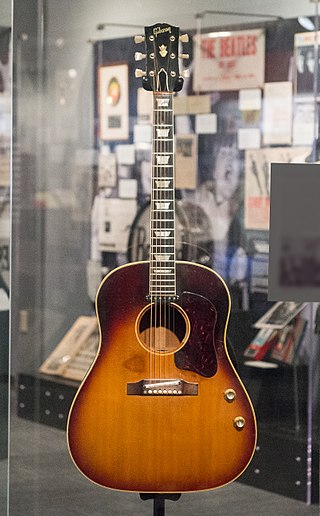Gibson J-160E
Acoustic-electric guitar From Wikipedia, the free encyclopedia
The Gibson J-160E is one of the first acoustic-electric guitars produced by the Gibson Guitar Corporation.
This article needs additional citations for verification. (January 2017) |
| Gibson J-160E | |
|---|---|
 John Lennon's 1962 Gibson J-160E | |
| Manufacturer | Gibson |
| Period | 1954–present |
| Construction | |
| Body type | Round-shoulder dreadnought |
| Neck joint | Dovetail |
| Woods | |
| Body | Sitka Spruce top Mahogany back and sides |
| Neck | Mahogany |
| Fretboard | Rosewood |
| Hardware | |
| Bridge | Rosewood |
| Pickup(s) | uncovered P-90[1] |
| Colors available | |
| Natural, Heritage Cherry Sunburst, Vintage Sunburst | |
The J-160E was Gibson's second attempt at creating an acoustic-electric guitar (the first being the small-body CF-100E[2]). The basic concept behind the guitar was to fit a single-pickup into a normal-size dreadnought acoustic guitar. The J-160E used plywood for most of the guitar's body, and was ladder-braced, whereas other acoustic Gibsons were X-braced. The rosewood fingerboard had trapezoid inlays, and the guitar had an adjustable bridge. For amplification, a single-coil pickup (an uncovered P-90 pickup)[1] was installed under the top of the body with the pole screws protruding through the top at the end of the fingerboard, with a volume and a tone knob.
John Lennon and George Harrison frequently used one with The Beatles, both on-stage and in the studio. Gibson produces a standard J-160E and a John Lennon J-160E Peace model, based on the J-160E he used during the Bed-In days of 1969. Epiphone makes an EJ-160E John Lennon replica signature model.
References
Wikiwand - on
Seamless Wikipedia browsing. On steroids.
